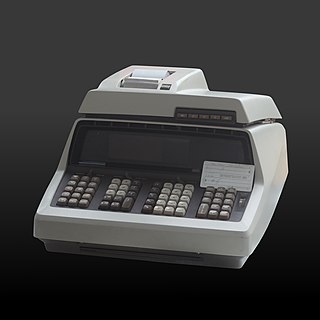RTL may refer to:
RTL may refer to:
In digital printing, a page description language (PDL) is a computer language that describes the appearance of a printed page in a higher level than an actual output bitmap. An overlapping term is printer control language, which includes Hewlett-Packard's Printer Command Language (PCL). PostScript is one of the most noted page description languages. The markup language adaptation of the PDL is the page description markup language.

Precision Architecture RISC (PA-RISC) or Hewlett Packard Precision Architecture, is a general purpose computer instruction set architecture (ISA) developed by Hewlett-Packard from the 1980s until the 2000s.

A logic analyzer is an electronic instrument that captures and displays multiple logic signals from a digital system or digital circuit. A logic analyzer may convert the captured data into timing diagrams, protocol decodes, state machine traces, opcodes, or may correlate opcodes with source-level software. Logic analyzers have advanced triggering capabilities, and are useful when a user needs to see the timing relationships between many signals in a digital system.
Very long instruction word (VLIW) refers to instruction set architectures that are designed to exploit instruction-level parallelism (ILP). A VLIW processor allows programs to explicitly specify instructions to execute in parallel, whereas conventional central processing units (CPUs) mostly allow programs to specify instructions to execute in sequence only. VLIW is intended to allow higher performance without the complexity inherent in some other designs.
In computer engineering, a hardware description language (HDL) is a specialized computer language used to describe the structure and behavior of electronic circuits, usually to design application-specific integrated circuits (ASICs) and to program field-programmable gate arrays (FPGAs).
Electronic design automation (EDA), also referred to as electronic computer-aided design (ECAD), is a category of software tools for designing electronic systems such as integrated circuits and printed circuit boards. The tools work together in a design flow that chip designers use to design and analyze entire semiconductor chips. Since a modern semiconductor chip can have billions of components, EDA tools are essential for their design; this article in particular describes EDA specifically with respect to integrated circuits (ICs).
Q, or q, is the seventeenth letter of the English alphabet.
Formal equivalence checking process is a part of electronic design automation (EDA), commonly used during the development of digital integrated circuits, to formally prove that two representations of a circuit design exhibit exactly the same behavior.
In computer engineering, logic synthesis is a process by which an abstract specification of desired circuit behavior, typically at register transfer level (RTL), is turned into a design implementation in terms of logic gates, typically by a computer program called a synthesis tool. Common examples of this process include synthesis of designs specified in hardware description languages, including VHDL and Verilog. Some synthesis tools generate bitstreams for programmable logic devices such as PALs or FPGAs, while others target the creation of ASICs. Logic synthesis is one step in circuit design in the electronic design automation, the others are place and route and verification and validation.
5 is a number, numeral, and glyph.

Hardware acceleration is the use of computer hardware designed to perform specific functions more efficiently when compared to software running on a general-purpose central processing unit (CPU). Any transformation of data that can be calculated in software running on a generic CPU can also be calculated in custom-made hardware, or in some mix of both.
The algorithmic state machine (ASM) is a method for designing finite-state machines (FSMs) originally developed by Thomas E. Osborne at the University of California, Berkeley (UCB) since 1960, introduced to and implemented at Hewlett-Packard in 1968, formalized and expanded since 1967 and written about by Christopher R. Clare since 1970. It is used to represent diagrams of digital integrated circuits. The ASM diagram is like a state diagram but more structured and, thus, easier to understand. An ASM chart is a method of describing the sequential operations of a digital system.

The Hewlett-Packard 9100A is an early programmable calculator, first appearing in 1968. HP called it a desktop calculator because, as Bill Hewlett said, "If we had called it a computer, it would have been rejected by our customers' computer gurus because it didn't look like an IBM. We therefore decided to call it a calculator, and all such nonsense disappeared."
Nonstop or non-stop may refer to:

MAtv is a Canadian community channels operated by the cable provider Vidéotron within the province of Quebec.

The mass media in Croatia refers to mass media outlets based in Croatia. Television, magazines, and newspapers are all operated by both state-owned and for-profit corporations which depend on advertising, subscription, and other sales-related revenues. The Constitution of Croatia guarantees freedom of speech and Croatia ranked 63rd in the 2016 Press Freedom Index report compiled by Reporters Without Borders, falling by 5 places compared to the 2015 Index.
Television in Belgium was introduced in 1953 and began with one channel each in Dutch and French. The country is heavily cabled, with 93% of households watching television through cable as of 2003.

The HP 64000 Logic Development System, introduced 17 September 1979, is a tool for developing hardware and software for products based on commercial microprocessors from a variety of manufacturers. The systems assisted software development with assemblers and compilers for Pascal and C, provided hardware for in-circuit emulation of processors and memory, had debugging tools including logic analysis hardware, and a programmable read-only memory (PROM) chip programmer. A wide variety of optional cards and software were available tailored to particular microprocessors. When introduced the HP 64000 had two distinguishing characteristics. First, unlike most microprocessor development systems of the day, such as the Intel Intellec and Motorola EXORciser, it was not dedicated to a particular manufacturer's microprocessors, and second, it was designed such that up to six workstations could be connected via the HP-IB (IEEE-488) instrumentation bus to a common hard drive and printer to form a tightly integrated network.
A1, A-1, A01 or A.1. may refer to:

Metropole Télévision SA, commonly known as Groupe M6, is a French media holding company. It was formed around the commercial television channel M6, launched in March 1987 by the CLT and La Lyonnaise des Eaux.